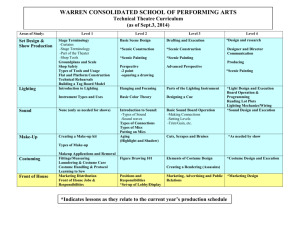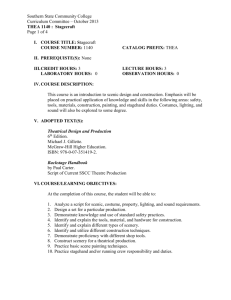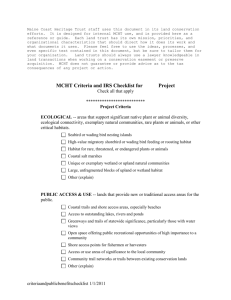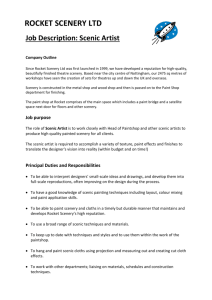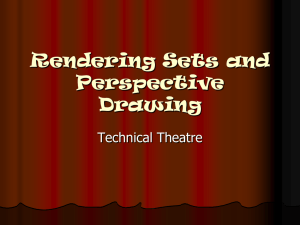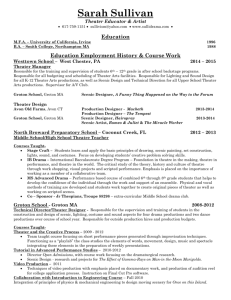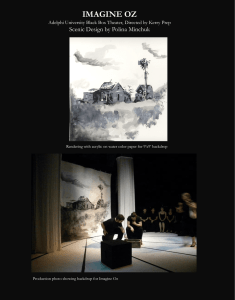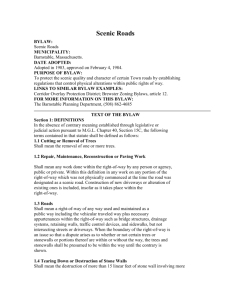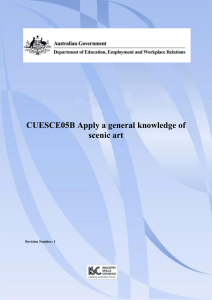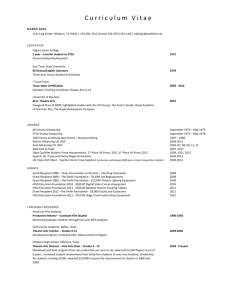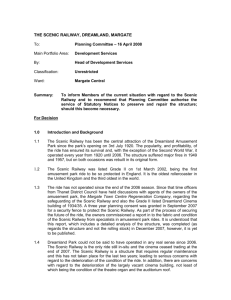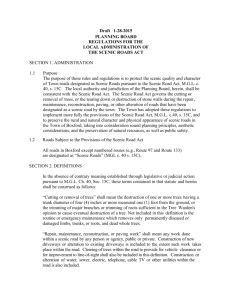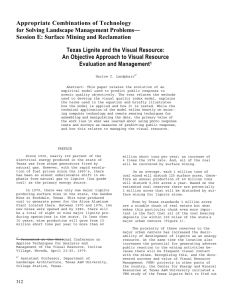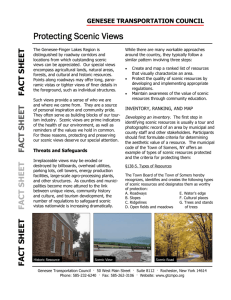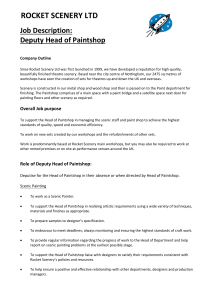IU Theatre Production Scale
advertisement
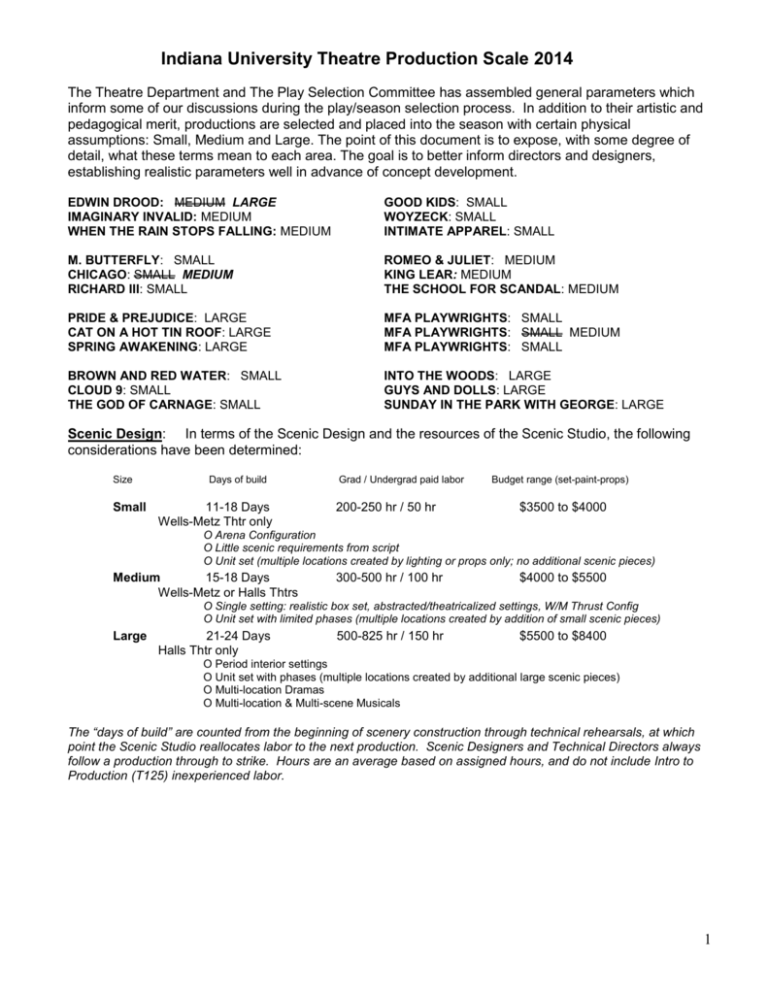
Indiana University Theatre Production Scale 2014 The Theatre Department and The Play Selection Committee has assembled general parameters which inform some of our discussions during the play/season selection process. In addition to their artistic and pedagogical merit, productions are selected and placed into the season with certain physical assumptions: Small, Medium and Large. The point of this document is to expose, with some degree of detail, what these terms mean to each area. The goal is to better inform directors and designers, establishing realistic parameters well in advance of concept development. EDWIN DROOD: MEDIUM LARGE IMAGINARY INVALID: MEDIUM WHEN THE RAIN STOPS FALLING: MEDIUM GOOD KIDS: SMALL WOYZECK: SMALL INTIMATE APPAREL: SMALL M. BUTTERFLY: SMALL CHICAGO: SMALL MEDIUM RICHARD III: SMALL ROMEO & JULIET: MEDIUM KING LEAR: MEDIUM THE SCHOOL FOR SCANDAL: MEDIUM PRIDE & PREJUDICE: LARGE CAT ON A HOT TIN ROOF: LARGE SPRING AWAKENING: LARGE MFA PLAYWRIGHTS: SMALL MFA PLAYWRIGHTS: SMALL MEDIUM MFA PLAYWRIGHTS: SMALL BROWN AND RED WATER: SMALL CLOUD 9: SMALL THE GOD OF CARNAGE: SMALL INTO THE WOODS: LARGE GUYS AND DOLLS: LARGE SUNDAY IN THE PARK WITH GEORGE: LARGE Scenic Design: In terms of the Scenic Design and the resources of the Scenic Studio, the following considerations have been determined: Size Small Days of build 11-18 Days Wells-Metz Thtr only Grad / Undergrad paid labor 200-250 hr / 50 hr Budget range (set-paint-props) $3500 to $4000 O Arena Configuration O Little scenic requirements from script O Unit set (multiple locations created by lighting or props only; no additional scenic pieces) Medium 15-18 Days Wells-Metz or Halls Thtrs 300-500 hr / 100 hr $4000 to $5500 O Single setting: realistic box set, abstracted/theatricalized settings, W/M Thrust Config O Unit set with limited phases (multiple locations created by addition of small scenic pieces) Large 21-24 Days Halls Thtr only 500-825 hr / 150 hr $5500 to $8400 O Period interior settings O Unit set with phases (multiple locations created by additional large scenic pieces) O Multi-location Dramas O Multi-location & Multi-scene Musicals The “days of build” are counted from the beginning of scenery construction through technical rehearsals, at which point the Scenic Studio reallocates labor to the next production. Scenic Designers and Technical Directors always follow a production through to strike. Hours are an average based on assigned hours, and do not include Intro to Production (T125) inexperienced labor. 1 Costume Design: Costume considerations are organized with the overall season in mind and based on pedagogical needs in both design and technology and the reality of overlapping build periods. In the costume area, musicals will always be considered ‘Large’ in regards to budget due to the expense of specialty items needed which might include shoes, shoe maintenance, foundation garments, tights, specialized dance wear, ensemble numbers and large chorus numbers to mention some. Size Small Medium Large Days of build Grad paid labor Budget (costumes, wigs, dry cleaning, shipping, rentals) 12-15 Days 300 hr $800 to $1200.00 (note that the 4 slot usually only has 9 days build not 12-15) 15-20 Days 400 hr $1400 to $2400.00 22-25 Days 500 hr $2500 to $6000.00 Of note: The “weeks of build” are counted until technical rehearsals disregarding the fact that work continues into tech and dress rehearsals. Hours are an average based on assigned hours. Graduate Assistants rotate per show so that one GA is off of each show to head wardrobe crew. Sound Design The size of a sound design is very difficult to estimate by reading the script alone, since there are generally very few specified sound effects listed. It is the concept phase of production that determines the size and complexity of most sound designs. What affects scale are adding microphones (either wireless or wired), bringing in a composer to the project, recording music and extensive voiceovers, wireless speakers and live musicians. It is critical that the need --or desire—to incorporate any of these must be considered during the play selection, or design concept phase, and be communicated to the sound designer or sound design faculty as early as possible. Musicals are always large in terms of the use of equipment, time required for proper set up and training of engineers. Lighting Design The scale of a lighting design relates much more closely to directorial approach than choice of play. Factors such as multiple locations called for in a script increase the complexity of a lighting design, though not necessarily its scale. Musicals are inherently more complex, which primarily plays out in terms of time required to properly tech more complicated cueing sequences consistent with the idiom of musical theater lighting. Physical considerations of the set design such as a ceiling, false proscenium or raked deck can come to bear, as well as large scale video projection. Where a script explicitly calls for elements like these, it is worth considering their impact on the scope of a lighting design, though other considerations are likely to flag such a script as potentially challenging in other ways as well. 2
